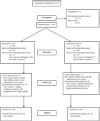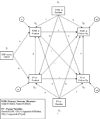Directionality of change in youth anxiety treatment involving parents: an initial examination
- PMID: 19485589
- PMCID: PMC2778202
- DOI: 10.1037/a0015761
Directionality of change in youth anxiety treatment involving parents: an initial examination
Abstract
This randomized clinical trial compared cognitive behavioral therapy (CBT) with minimal parent involvement to CBT with active parent involvement in a sample of 119 youths (7-16 years old; 33.6% Caucasian, 61.3% Latino) with anxiety disorders. The dynamics of change between youth anxiety and parent variables (positive-negative behaviors toward the child, conflict in the parent-youth relationship, and parental anxiety) in both treatment conditions over pretreatment, posttreatment, and 12-month follow-up were also examined. Results indicated that youth anxiety was significantly reduced with both treatments and that the dynamics of change may not solely flow from parent to youth but also from youth to parent. Findings highlight the need for research on directionality and mechanisms of change to move from evidence-based treatments toward evidence-based explanations of treatment outcome.
Copyright 2009 APA
Figures
References
-
- Achenbach TM. Manual for the Child Behavior Checklist/4–18. Burlington, VT: University of Vermont, Department of Psychiatry; 1991.
-
- Achenbach TH, McConaughy SH, Howell CT. Child/adolescent behavioral emotional problems: Implications of cross-informant correlations for situational specificity. Psychological Bulletin. 1987;101:213–232. - PubMed
-
- Barmish A, Kendall PC. Should parents be co-clients in cognitive-behavioral therapy for anxious youth? Journal of Clinical Child and Adolescent Psychology. 2005;34:569–581. - PubMed
-
- Barrett PM, Dadds MR, Rapee RM. Family treatment of childhood anxiety: A controlled trial. Journal of Consulting and Clinical Psychology. 1996;64:333–342. - PubMed
-
- Bird HR, Shaffer D, Fisher P, Gould MS, et al. The Columbia Impairment Scale (CIS): Pilot findings on a measure of global impairment for children and adolescents. International Journal of Methods in Psychiatric Research. 1993;3:167–176.



